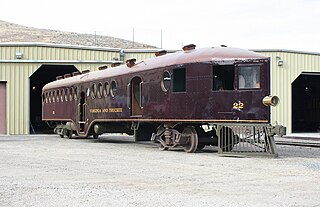
Minden is a census-designated place (CDP) in Douglas County, Nevada, United States. The population was 3,001 at the 2010 census. It is the county seat of Douglas County and is adjacent to the town of Gardnerville. The Douglas campus of the Western Nevada College is located in Minden.

Shaniko is a city located in Wasco County, Oregon, United States, on U.S. Route 97 and about 8 miles (13 km) north of Antelope. The population was 30 at the 2020 census.

Malakoff Diggins State Historic Park is a state park unit preserving the largest hydraulic mining site in California, United States. The mine was one of several hydraulic mining sites at the center of the 1882 landmark case Woodruff v. North Bloomfield Mining and Gravel Company. The mine pit and several Gold Rush-era buildings are listed on the National Register of Historic Places as the Malakoff Diggins-North Bloomfield Historic District. The "canyon" is 7,000 feet (2,100 m) long, as much as 3,000 feet (910 m) wide, and nearly 600 feet (180 m) deep in places. Visitors can see huge cliffs carved by mighty streams of water, results of the mining technique of washing away entire mountains of gravel to wash out the gold. The park is a 26-mile (42 km) drive north-east of Nevada City, California, in the Gold Rush country. The 3,143-acre (1,272 ha) park was established in 1965.
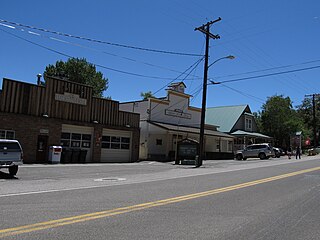
Genoa is an unincorporated town in Douglas County, Nevada, United States. Founded in 1851, it was the first settlement in what became the Nevada Territory. It is situated within Carson River Valley and is approximately 42 miles (68 km) south of Reno. The population was 939 at the 2010 census. It is home to the oldest bar in the state of Nevada which opened in 1853.
Frederic Joseph DeLongchamps was an American architect. He was one of Nevada's most prolific architects, yet is notable for entering the architectural profession with no extensive formal training. He has also been known as Frederick J. DeLongchamps, and was described by the latter name in an extensive review of the historic importance of his works which led to many of them being listed on the U.S. National Register of Historic Places in the 1980s.

The Great Atlantic and Pacific Tea Company Warehouse is a historic formerly commercial building at 150 Bay Street in Jersey City, Hudson County, New Jersey, United States. Built as a warehouse for The Great Atlantic & Pacific Tea Company (A&P) in 1900, it is the major surviving remnant of a five-building complex of the nation's first major grocery store chain. It was designated a National Historic Landmark in 1978, and now houses a mix of residences and storage facilities.
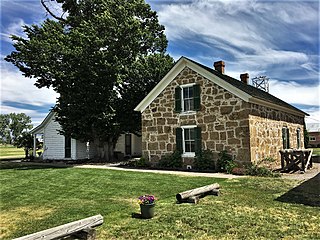
The Dangberg Home Ranch Historic Park is a Douglas County, Nevada, USA, park, preserving one of the state's first ranches.

Montgomery Park is an office building and former Montgomery Ward mail-order catalog warehouse and department store located in Portland, Oregon, United States, built in 1920. It is listed on the National Register of Historic Places under its historic name Montgomery Ward & Company Building. The building is located on property once used for the Lewis and Clark Centennial Exposition, of 1905. It was occupied by Montgomery Ward from 1920 until 1985, although the majority of the company's operations at this location ended in 1982. The building is the second-largest office building in Portland with 577,339 square feet (53,636.5 m2).

The Wool Warehouse is a historic building in the Warehouse District of downtown Albuquerque, New Mexico. Built in 1928–29 by wool merchant Frank Bond, the warehouse is significant for its role in New Mexico's wool industry in the mid-20th century. It was added to the New Mexico State Register of Cultural Properties in 1980 and the National Register of Historic Places in 1981.
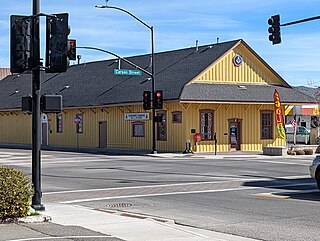
The Virginia & Truckee (V&T) Railroad Depot of Carson City, Nevada is a historic railroad station that is listed on the U.S. National Register of Historic Places (NRHP). It is significant for its association with the economically important role of the V&T railroad historically in Carson City following discovery of the Comstock Lode mine in 1859. To a lesser degree, according to its NRHP nomination, the depot building is also significant architecturally "as a well-preserved example of a wood-frame passenger depot procured from a railroad company pattern book within the V&T's former sphere of operation."

Farmer's Bank of Carson Valley is a historic bank building located at 1596 Esmeralda Avenue in Minden, Nevada. The building was built in 1909 to house the Farmer's Bank of Carson Valley, which was chartered in the same year. H. F. Dangberg, the founder of Minden, commissioned the building, which was only the second building built in the town. In 1918, the bank outgrew its original building and moved to a larger building across the street. After the bank left the building, it was occupied by the Minden Post Office until 1974. The building has housed a variety of businesses since and is currently occupied by the Bank Parlor and Pub.

Farmer's Bank of Carson Valley is a historic bank building at 1597 Esmeralda Avenue in Minden, Nevada. It was built from 1916 to 1918 to replace the original 1909 bank building, which the Farmer's Bank had outgrown. Prominent Nevada architect Frederic Joseph DeLongchamps designed the building in the Classical Revival style; the bank is one of many Neoclassical structures in Minden designed by DeLongchamps. It features a cornice with terra cotta tiles and bands, a flat roof with a low parapet, and an entrance portico with Ionic columns. It was built for Farmer's Bank organizer H. F. Dangberg, who was also the founder of Minden. It served as a bank until 1968; it currently houses offices.

The Carson Valley Improvement Club Hall is a historic building located at 1606 Esmeralda Avenue in Minden, Nevada. The building was constructed in 1912 as a meeting hall for the Carson Valley Improvement Club. The two-story building features a variety of brickwork patterns but has an otherwise plain design. The Carson Valley Improvement Club used the building to host both community social events and town meetings. The building has served as the informal seat of government in Minden since its construction; after the Carson Valley Improvement Club moved out in 1920, the Minden Commercial Club and later the Minden Town Board continued to hold government meetings at the building. Though Minden is unincorporated, the groups meeting in this building have acted as local liaisons to Douglas County's government and have helped manage local government services. In addition, the building has continued to house a variety of social events, including concerts, movies, religious services, and basketball games.
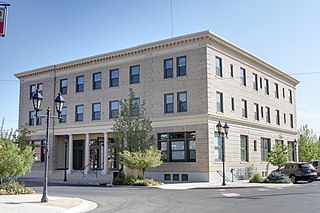
The Minden Inn is a historic hotel building located at 1594 Esmeralda Avenue in Minden, Nevada. Built from 1912 to 1916, the building was designed by prominent Nevada architect Frederic Joseph DeLongchamps in the Classical Revival style. The hotel was the largest commercial building in Minden and was operated by H. F. Dangberg, the founder of the town. The inn earned a reputation as "one of the finest small hotels on the West Coast" and was visited by a number of actors and celebrities who passed through Minden on the Virginia and Truckee Railroad. In addition, the hotel included a bar and gambling operations until 1987. The building now houses Douglas County offices.

The Minden Flour Milling Company is a historic flour mill located at 1609 U.S. Highway 395 in Minden, Nevada. Built in 1906, the mill was the largest of five flour mills built in the Carson Valley and is the only one still in existence. The building has a transitional design in two respects, as it reflects the change from early European-influenced mills to 20th-century American mills as well as the move from smaller rural mills to large mills built along railroads. The mill features a masonry bearing-wall style of construction, a concrete foundation considered novel at the time, and well-crafted masonry and woodwork. The operators of the mill had a significant influence on Minden commerce, as they were instrumental in both the extension of the Virginia and Truckee Railroad to the town and the expansion of electric power to the area. By the 1920s, the mill had become "one of the biggest milling concerns in the state"; it could process 100 barrels of flour a day and also produced chicken and cattle feed. The mill operated until the 1960s.
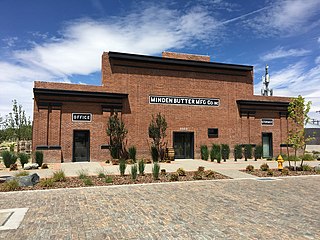
The Minden Butter Manufacturing Company, also known as the Minden Creamery, is a historic creamery building located at 1617 Water St. in Minden, Nevada. Built in 1916, the creamery was designed by noted Nevada architect Frederic Joseph DeLongchamps. The creamery replaced the Minden Butter Manufacturing Company's first building, which was built in 1908, so the company would have space to pasteurize its products. The company sold butter and other produce under the Windmill brand name and eventually became the largest creamery in Nevada. While the company mainly shipped its goods to the San Francisco area, it also sold internationally; the year before the creamery was built, it sent a large shipment of butter to China. The creamery building is now used by Bently Nevada for manufacturing purposes.
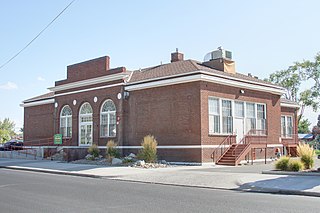
Minden Elementary School, also known as Minden Grammar School, is a historic school building located at 1638 Mono Avenue in Minden, Nevada. The Renaissance Revival school was built in 1918 at a cost of $14,291. The school replaced the county's first school, a 1908 building known as the "little green schoolhouse". The school operated until it closed in 1980 and now serves as an office building for the Douglas County School District.

The Gardnerville Branch Jail is a historic jail located at 1440 Courthouse St. in Gardnerville, Nevada. The jail was built in 1910 and served as Douglas County's only jail from 1910 to 1915. Prior to 1910, the only county jail was in Genoa, the county seat; however, since Gardnerville was several miles from Genoa, it resorted to housing prisoners in the local judge's granary. As the granary was considered unfit for holding prisoners, the community petitioned the county to construct a new jail. However, local leaders in Minden, who wanted to move the county seat to their town, protested the move, as they suspected that Gardnerville was attempting to claim the county seat itself. Nonetheless, the county approved the construction of the new jail. The jail housed its first prisoners before construction even finished, as the Genoa jail burned down; one prisoner was briefly chained to a post until the new jail could accommodate him. Once completed, the jail served the county until 1915, when Minden became the county seat and opened its own county jail.
The Wool Warehouse, on E. Bridger in Bridger, Montana, was built around 1900. It was listed on the National Register of Historic Places in 1987.











